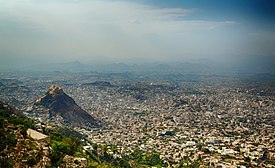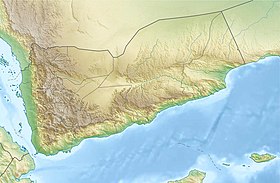Taiz
Taiz
ّتَعِز | |
|---|---|
     Overview of Taiz | |
 Taiz Location within Yemen | |
| Coordinates: 13°34′44″N 44°01′19″E / 13.57889°N 44.02194°E | |
| Country | Yemen |
| Governorate | Taiz |
| Elevation | 1,400 m (4,600 ft) |
| Population (2014) | |
| • Total | 615,222 |
| Time zone | UTC+3 (Yemen Standard Time) |
Taiz (Arabic: تَعِزّ, romanized: Taʿizz) is a city in southwestern Yemen. It is located in the Yemeni Highlands, near the port city of Mocha on the Red Sea, at an elevation of about 1,400 metres (4,600 ft) above sea level. It is the capital of Taiz Governorate. With a population of over 600,000 in 2005, it is the third largest city in Yemen after the capital Sana'a and the southern port city of Aden.[1]
Due to the ongoing campaign as part of Yemen's civil war, Taiz is a battleground and a war zone.[2] Once known as the "cultural capital of Yemen",[3] the war has bestowed a new title, "city of snipers".[4]
History[]

The 14th century traveller Ibn Battuta visited Taiz:
We went on ... to the town of Taʻizz, the capital of the king of Yemen, and one of the finest and largest towns in that country. Its people are overbearing, insolent, and rude, as is generally the case in towns where kings reside. Taʻizz is made up of three quarters; the first is the residence of the king and his court, the second, called ʽUdayna, is the military station, and the third, called al-Mahálib, is inhabited by the commonalty, and contains the principal market.[5]
Medieval[]
Taiz was ruled by Turan-Shah, the older brother of Saladin, after he had conquered Yemen in 1173 CE.[6] Turan-Shah built the citadel on the hill overlooking the old city.[7] In 1175 CE, Taiz was made the capital of Yemen as it was incorporated into dominions of the Ayyubid dynasty by Turan-Shah.
The second Rasulid King, Almaddhafar (1288 CE), established Taiz as the second capital of the Rasulid Dynasty after Zabid.[8] In 1332 Ibn Battutah visited Taiz and described it as one of the largest and most beautiful cities of Yemen.[9]
In 1500, the capital was moved to Sana'a by the ruler of the Taharid dynasty. In 1516 Taiz came under Ottoman control.
20th century[]
In 1918 the Ottomans lost Taiz to the newly independent Mutawakkilite Kingdom of Yemen.
Taiz remained a walled city until 1948, when Imam Ahmed made it the second capital of Yemen, allowing for expansion beyond its fortified wall.[10] In the 1960s, the first purified water system in Yemen was opened in Taiz. In 1962, state administrations moved back to Sana'a.
Yemeni uprising and war[]
During the Yemeni Revolution fighting in Taiz resulted in anti-government forces seizing control of the city from president Ali Abdullah Saleh.
As part of the 2015 Yemeni Civil War, on 22 March 2015, the Houthis and forces loyal to former president Ali Abdullah Saleh took the city in the aftermath of their coup d'état in Sana'a.[11] The city became the site of a military confrontation between Houthis and the forces loyal to Abd Rabbuh Mansur Hadi. The city was effectively under siege and the United Nations warned of an "extreme and irreversible" food shortage if fighting continued.[12] In August 2015, Yemeni Member of Parliament Muhammad Muqbil Al-Himyari reported Houthi attacks on civilians in Taiz and appealed for help on Suhail TV (Yemen).[13][14]
The 2015 confrontation expanded into a military campaign for control of this strategic city.[3] Despite ceasefires and prisoner swaps, the battle continues to this day and the city has been described as a "volatile front line."[2] The frontline runs through the city from east to west, and journeys across the frontline that once took 5 minutes now take 5 hours.[4]
Geography[]
Climate[]
Taiz has a hot semi-arid climate (Köppen climate classification: BSh). The average daily temperature high during August is 32.5 °C (90.5 °F). Annual rainfall of Taiz is around 600 millimetres (24 in), but on Jabal Sabir it is probably around 1,000 millimetres (39.4 in) per year.
| hideClimate data for Taiz | |||||||||||||
|---|---|---|---|---|---|---|---|---|---|---|---|---|---|
| Month | Jan | Feb | Mar | Apr | May | Jun | Jul | Aug | Sep | Oct | Nov | Dec | Year |
| Average high °C (°F) | 24.3 (75.7) |
26.4 (79.5) |
27.9 (82.2) |
28.3 (82.9) |
29.0 (84.2) |
31.3 (88.3) |
32.5 (90.5) |
31.7 (89.1) |
31.3 (88.3) |
31.1 (88.0) |
27.6 (81.7) |
26.1 (79.0) |
29.0 (84.2) |
| Daily mean °C (°F) | 17.7 (63.9) |
19.9 (67.8) |
22.1 (71.8) |
23.6 (74.5) |
24.3 (75.7) |
25.6 (78.1) |
26.4 (79.5) |
25.4 (77.7) |
24.6 (76.3) |
24.0 (75.2) |
21.7 (71.1) |
20.0 (68.0) |
22.9 (73.2) |
| Average low °C (°F) | 11.1 (52.0) |
13.3 (55.9) |
16.3 (61.3) |
18.8 (65.8) |
19.5 (67.1) |
19.9 (67.8) |
20.2 (68.4) |
19.1 (66.4) |
17.8 (64.0) |
16.9 (62.4) |
15.7 (60.3) |
13.9 (57.0) |
16.9 (62.4) |
| Average rainfall mm (inches) | 9 (0.4) |
12 (0.5) |
37 (1.5) |
68 (2.7) |
89 (3.5) |
73 (2.9) |
60 (2.4) |
89 (3.5) |
110 (4.3) |
91 (3.6) |
17 (0.7) |
5 (0.2) |
660 (26.2) |
| Source 1: Hydrological Sciences[15] | |||||||||||||
| Source 2: Journal of Environmental Protection[16] | |||||||||||||
Landmarks[]

The city has many old quarters, with houses that are typically built with brown bricks, and mosques are usually white. Most famous among the mosques are the Ashrafiya, the and the Mudhaffar. Also memorable are the old citadel and the governor's palace that rests on top of a mountain spur 450 m (1,480 ft) above the city centre. It also has one of the best-known mountains in Yemen, Jabal Saber,[1] almost 3,000 metres (1.9 miles) above sea level), which affords panoramic views over the city.
Economy[]
Historically, the mountainous city of Taiz was known for coffee production. The Mocha coffee produced in Taiz was considered some of the finest in the region in the early 20th century.[17] Today, coffee remains a major part of the economy but mango, pomegranate, citrus, banana, papai, vegetables, cereals, onions, and qat are also grown in the surrounding landscapes.[18] Taiz is also known for its cheese. It is produced in rural areas like Araf, Awshaqh, Akhuz, Bargah, Barah, Jumah, Mukyas, Suayra, Kamb and Hajda and sold in Bab al-Kabeer and Bab Musa markets.[19][20]
Industries in the city of Taiz include cotton-weaving, tanning and jewelry production. Taiz today is the largest industrial base in Yemen.[citation needed]
Transport[]
Taiz has many road connections with the rest of the country. The city is served by Ta'izz International Airport.[21]
As of 2020, all roads to and from Ta'iz, except for one, are controlled by the Houthi movement.[4]
Zoo[]
Like Sana'a Zoo, this zoo held fauna caught in the wild, such as the Arabian leopard, besides exotic animals such as African lions and gazelles.[22]
Notable people[]
- Amat Al Alim Alsoswa
- Abdel Karim al-Khaiwani
- Bushra al-Maqtari
- Ali al-Muqri
- Maeen Abdulmalik Saeed
- Hisham Sharaf
See also[]
References[]
- ^ Jump up to: a b Hestler, Ann; Spilling, Jo-Ann (2010). "1: Introduction". Yemen. New York City: Cavendish. p. 17. ISBN 978-0-7614-4850-1.
- ^ Jump up to: a b "Warring Yemen parties carry out prisoner swap in front-line Taiz". Reuters. 2019-12-19. Retrieved 2019-12-20.
- ^ Jump up to: a b Waguih, Asmaa (2016-07-12). "The Battle Over Yemen's Cultural Capital Continues". Foreign Affairs : America and the World. ISSN 0015-7120. Retrieved 2019-04-13.
- ^ Jump up to: a b c Doucet, Lyse (2020-03-15). "In the rubble of Taiz, all roads to a normal life are blocked". The Guardian. ISSN 0261-3077. Retrieved 2020-03-16.
- ^ H.A.R. Gibb, translator, Ibn Battúta: Travels in Asia and Africa, 1325-1354, London, 1929, p. 108-109
- ^ Lane-Poole, Stanley (2013-10-03). A History of Egypt: Volume 6, In the Middle Ages. Cambridge University Press. p. 197. ISBN 9781108065696.
- ^ Steven C. Caton: Yemen. ABC-CLIO, 2013, p.52
- ^ Mackintosh-Smith, Tim (2014-06-03). Yemen: The Unknown Arabia. The Overlook Press. p. 305. ISBN 9781468309980.
- ^ First Encyclopaedia of Islam: 1913-1936. BRILL. 1993. p. 626. ISBN 9-0040-9796-1.
- ^ Gibb, Hamilton Alexander Rosskeen (1998). The Encyclopaedia of Islam: TAHRIR-TARDJAMA. Brill. p. 118.
- ^ "Rebels Seize Key Parts of Yemen's Third-Largest City, Taiz". The New York Times. 22 March 2015. Retrieved 22 March 2015.
- ^ "UN warns of 'extreme' and 'irreversible' food shortage in Taiz". Al Jazeera. Al Jazeera. 30 October 2015. Retrieved 14 November 2015.
- ^ "#5060 - Yemeni MP Muhammad Muqbil Al-Himyari Breaks Down in Tears When Discussing Situation in Taiz, Yemen Suhail TV". Memritv. August 24, 2015.
- ^ "Transcript #5060 - Yemeni MP Muhammad Muqbil Al-Himyari Breaks Down in Tears When Discussing Situation in Taiz, Yemen". Memritv. August 24, 2015.
- ^ "Rainfall and Runoff in Yemen" (PDF). Hydrological Sciences. Archived from the original (PDF) on 2013-05-12. Retrieved 2013-03-18.
- ^ Al-Buhairi, Mahyoub H.; "Analysis of Monthly, Seasonal and Annual Air Temperature Variability and Trends in Taiz City - Republic of Yemen"; in Journal of Environmental Protection, 2010 (1) ; pp. 401-409
- ^ Prothero, G.W. (1920). Arabia. London: H.M. Stationery Office. p. 83.
- ^ Yementourism.com, http://www.yementourism.com/services/touristguide/detail.php?ID=2044
- ^ https://www.albawaba.com/say-yemeni-cheese
- ^ https://arab24.com/portal/index.php/arab24-stories/yemen/item/15999-2019-06-20-12-02-03
- ^ El Mallakh, Ragaei (2014). "Infrastructure". The Economic Development of the Yemen Arab Republic (RLE Economy of Middle East). Routledge. ISBN 978-1-3175-9810-7.
- ^ De Haas van Dorsser, F. J.; Thowabeh, N. S.; Al Midfa, A. A.; Gross, Ch. (2001), Health status of zoo animals in Sana'a and Ta'izz, Republic of Yemen (PDF), Sana'a, Yemen: Breeding Centre for Endangered Arabian Wildlife, Sharjah; Environment Protection Authority, pp. 66–69, retrieved 2019-05-05
External links[]
![]() Media related to Ta'izz at Wikimedia Commons
Media related to Ta'izz at Wikimedia Commons
- ArchNet.org. "Taizz". Cambridge, Massachusetts, USA: MIT School of Architecture and Planning. Archived from the original on 2008-05-05.
- Taiz
- Capitals of former nations
- Populated places in Taiz Governorate


